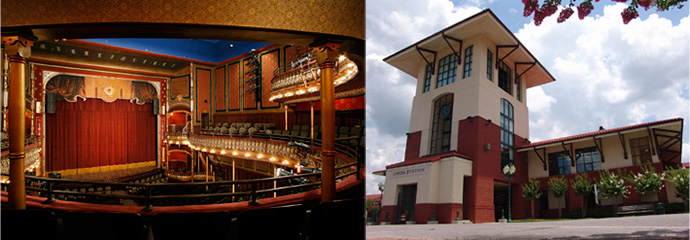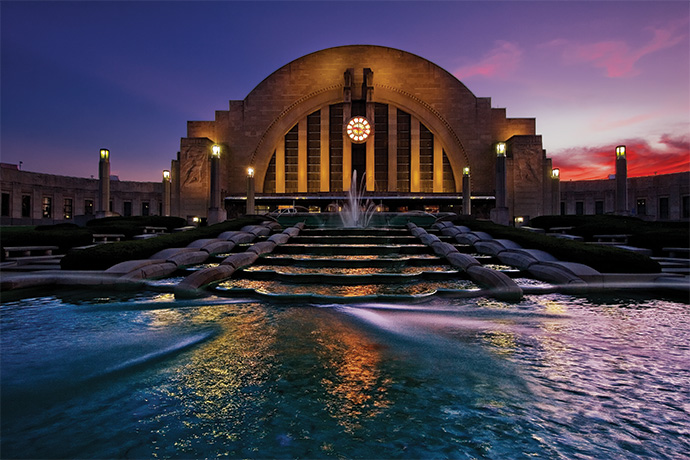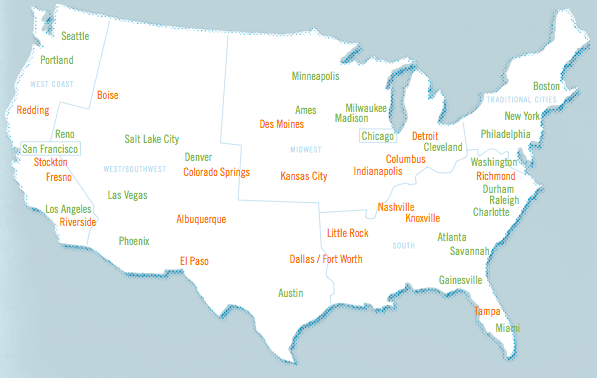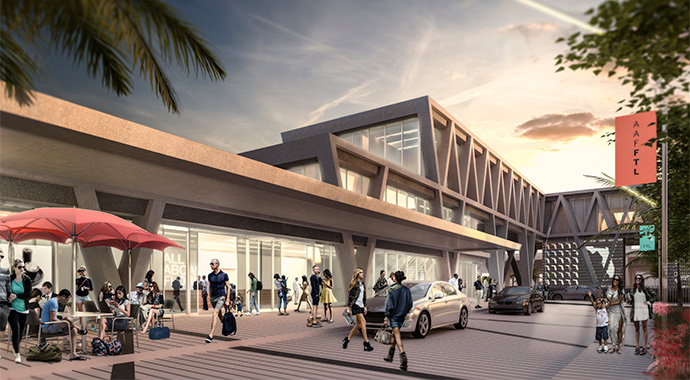John Robert Smith knows a thing or two about small cities, and about the role of transportation in helping them think bigger.
The former Mayor of Meridian, Miss., a town of 43,000, is co-chairman of Transportation for America and a senior policy advisor to Smart Growth America, which in 2013 merged with Reconnecting America, where he served as president and CEO and on that organization’s board. Smith is a former Chairman of Amtrak’s board, and a former member of the transportation committees of the National League of Cities and the U.S. Conference of Mayors, as well as former co-chairman of the National Forum on the Future of Passenger Rail.
First elected to the Meridian City Council 25 years ago, he was elected mayor in 1993 and led the drive to renovate the City of Meridian’s Union Station, a $7-million historic restoration project that created a new multimodal transportation center, dramatically increased use of the station, raised property values and city tax receipts, and lowered crime in the station’s neighborhood.
More recently he made headlines in 2013 for going toe-to-toe on the funding of Amtrak at a US House of Representatives Transportation and Infrastructure Committee hearing run by Congressman John Mica, who has steadfastly called for defunding and privatizing Amtrak. Mica, then the chairman of the committee, also was first elected in 1993, representing Florida’s 7th congressional district — which in July this year got the good news that the FAA had approved Orlando International Airport’s economic development plan to construct its own new intermodal center and people-mover connection to the new facility and to future airport expansion.
“This will be one of the most significant transportation and development projects of the next decade,” said Mica, who earlier this year cheered the inclusion of Central Florida’s SunRail II rail transit project in the federal budget. “Combined with Gov. Rick Scott’s commitment of $214 million and other revenues paid by those who will use the facility in the future, the approval of this plan will prepare and equip our region for business, tourism and commercial activity for decades to come.”
Earlier this year, in saluting Gov. Scott’s commitment of the funds, Mica sounded more like a transit-oriented-development devotee:
“I visited Miami’s nearly complete intermodal center yesterday,” he said in February, “and that $2.2-billion project connects Miami International Airport with Metrorail and, in several months, will have a TriRail station opening, allowing passengers to connect to all of South Florida. We learned from the Miami experience — where they waited too long and delayed for decades — failing to connect their transportation systems together cost them dearly in ridership, use and passenger service for decades and also drove up costs for their project.”
Nearly as important as connecting modes to each other is connecting each of them to money.
“Now, even the highway system is problematic,” says Smith during a conversation this fall, referencing the shortfall in gas tax revenue that’s threatening federal transportation funding. Meanwhile, Amtrak and the ever-busier freight railroads are coming to legal blows over congestion that, for instance, has led to routine four-hour delays for passenger trains just trying to get from Cleveland to Chicago. The latest volley was a Nov. 17 complaint filed by Amtrak asking the Surface Transportation Board to investigate Norfolk Southern Railway and CSX Transportation for causing unacceptable delays for passengers traveling between Chicago and Washington, D.C., on the Capitol Limited service.
The constant head-butting on national policy issues has led some jurisdictions to simply see what they can do on the local level. That was the theme of Transportation for America’s “Capital Ideas” conference earlier this month in Denver, where representatives from 30 states announced a new network to support state efforts to pass legislation to raise transportation funding while improving accountability for spending it.
“Federal gas tax revenues are dropping and prospects of returning to robust national investment are uncertain, at best,” said T4America director James Corless. “States that want to continue investing will have to explore new ways to raise funding for transportation on their own.”
Crossroads at a Crossroads
Twenty states considered legislation to increase transportation funding in some form in 2013. Since 2012, 12 states have successfully raised new revenues. A handful of other state legislative leaders and governors have already indicated that transportation funding will be on the front burner in 2015, says T4America.
“They say that states are the laboratories of democracy,” said Smith in Denver. “And many are proving right now how to stand in the gap created by federal inaction. But to fulfill their homegrown solutions, they need help with everything from finding innovative revenue sources to crafting political strategies and legislative language. Our hope is that this new network will help replicate success across the country and empower states and regions that want to make this happen.”

“There is still an enormous opportunity,” said Corless, “because Congress still must update the federal transportation program, MAP-21, by next May. This gives us an important chance to resuscitate and reinvigorate the program in exciting ways, so that it better suits the needs of people in the communities where they live.”
Smith in his interview with Site Selection recounts his own community’s homegrown solution, starting with a scenario familiar to many.
“Meridian had seen population erode for decades, and the downtown was a dying downtown,” he said of his city, which today has a population of about 43,000. “Many streets were virtually absent of any kind of traffic or business. Downtown closed up after five. I lived with my two children within three blocks of city hall — we thought it was great to have the place to ourselves.”
But community leaders knew it really wasn’t so great. Smith says there are three things city or town leaders have to ask themselves when looking at changing their course:
-
Who were you when your founding fathers decided there should be a city or town there?
“In Meridian’s case, it was transportation infrastructure. It was the crossroads of two railroads, and they needed a town to sustain those railroads in the 1850s. Seventy percent of the population base could be reached through Meridian, principally rail. We drew General Sherman also because of that, but it was rebuilt by German Jewish immigrants after the Civil War, again because of the transportation infrastructure. -
Who are you now?
“It has to be an unvarnished look at what you’ve become, good or bad, and if you’ve walked away from those historic strengths.” -
Who do you aspire to be?
“A community has a personality like a human being does. When you walk into the community, it’s positive, upbeat and believes in its future, or, like Meridian was, it’s developed an inferiority complex.”
Things started small in Meridian’s downtown transformation, with the city under Smith’s leadership applying for a $35,000 grant from the railroad administration for a multimodal transportation center. “For me it was as much an economic development tool as a transportation tool,” said Smith. “When you get people using various modes coming together in one place downtown, that will create traffic, which has to create some economic heat.”
At that time, transportation enhancement funds for rail and transit were coming available from the federal Intermodal Surface Transportation Efficiency Act of 1991. “So we built the South’s first multimodal transportation center in 1997, which brought the Amtrak Crescent through Meridian, the inner city bus system, the local transit system and taxi service together in one place at the site of a historic train station,” said Smith. The project was mostly funded by ISTEA, with the city pitching in $1.3 million, and prepaid leases from Amtrak, Greyhound and the economic development authority of the county.
“It quickly became the most heavily used public space in Meridian, and led to $135 million in additional public and private investment within three blocks of that station,” said Smith. “We now have condominiums you’d have to walk into to believe they’re in downtown Meridian.” Night spots, a performing arts and conference center that draws national and international acts, and the Meridian branch campus of Mississippi State University have grown downtown. And the ambience is proving appealing to young people looking for downtown accommodations and amenities, as well as to the military population from Naval Air Station Meridian just outside town, where 60 percent of the strike pilots in the US Navy train.
“They are looking for similar things, they have money to spend, and they bring a life and vibrancy to a community,” Smith says of the Navy and Marine personnel and the university students. “Where you have a college or a military installation, you have an opportunity not only while they’re there, but to present to them a city they can come back to and invest themselves.”
New Models
Smith says 16 years leading Meridian taught him that the old model of offering free property and infrastructure access to corporate investor prospects was no longer enough. They were looking more and more at the kind of place it was, and the quality of life their executives and employees would find there. Smith offers examples.
“We have three large hospitals, so healthcare is a huge industry,” he says, “but our hospitals were having trouble recruiting the physicians they needed. Families came and said, ‘Where are the things we’re looking for, like entertainment and places to go for nice meals.’ I have a very good friend in Alabama who’s an economic developer, who was working a project that would bring 200 engineers. But when they were about to close the deal, the site selectors said, ‘We can’t come here. There’s nothing but chain restaurants, and no place to come downtown and have a meal and see high-quality entertainment. You can pay me a lot, but what do I do with that?’ “

It’s not all about logistics. Those higher learning institutions have been crucial partners to many refashioned downtown districts.
“I’ve been to cities where there is a total disconnect of the college from the city itself, and neither one plays to the other or sees the other as a critical component of their success, and that’s a great disservice to both,” says Smith. “Sometimes colleges are aloof from the city government and downtown, and insulated on the campus, and then you’ll find cities and towns that don’t recognize that university as the tremendous economic development asset that it is. You have to see the success of each other as critically important to the future.”
Technology and improved interconnectivity also have helped bring smaller places such as Meridian into play for site selections. But so have changed priorities, says Smith.
“Young people are making vastly different decisions than we did as baby boomers,” he says. “We said, ‘Who will hire me, and I will go there.’ Young people are saying, ‘Where do I want to be, and then I will go find a job.’ They are looking for places that are authentic.”
A study released earlier this year by The Rockefeller Foundation and Transportation for America found that 40 percent of Millennials surveyed in 10 major US cities were looking to live in smaller towns and cities — “It’s not all about going to Chicago or San Francisco,” says Smith. More than half (54 percent) of those surveyed say they would consider moving to another city if it had more and better options for getting around, and 66 percent said that access to high-quality transportation is one of the top three criteria they would weight when deciding where to live.
Smith says older folks like downtowns too. In Meridian they, like their younger counterparts, can walk to the opera house, walk to dinner at Weidmann’s Restaurant and also easily get to campuses for continuous learning courses at Mississippi State or Meridian Community College.
He says Hattiesburg and Jackson in Mississippi have pursued projects similar to what transpired in Meridian, built around their own passenger rail stations. Birmingham is “finally getting on track with a new station downtown,” he says, and New Orleans has plans to dramatically improve its terminal.
Economists estimate that All Aboard Florida — an intercity passenger rail project being developed by Florida East Coast Industries, Inc., that will connect Miami to Orlando with intermediate stations in Fort Lauderdale and West Palm Beach — will add more than $6 billion to Florida’s economy over the next eight years.
Worth the Risk
Other examples further north were profiled in two recent intermodal station case studies from Good Jobs First, which highlighted Uptown Station in Normal, Ill., and Union Depot in St. Paul, Minn. Both were partially funded through federal grants including the U.S. DOT’s Transportation Investment Generating Economic Recovery (TIGER) program.
According to Good Jobs First, the construction of Uptown Station, which connects Amtrak, local transit, intercity buses, bicycling, autos and pedestrians, created approximately 140,000 hours of work for skilled construction workers. Private spinoff development anchored by the transit center totals $220 million.

In St. Paul, the restoration of historic Union Depot created 660,000 hours of work for about 2,000 workers in at least 13 different crafts. The station integrates Amtrak, local and intercity bus, pedestrian, bicycle, personal vehicle and light rail access.
“Towns large and small are playing to their historic strengths, because those are the bones of the authenticity of the community, and people want to be in that environment, and stay there after work,” says Smith, adding that he thinks the banks have caught on too.
“There was a time if you wanted to invest in downtown, a banker would look askance,” he says, noting that Meridian was the site of the first tax-increment-finance deal in Mississippi. Helping the equation for projects is already-installed infrastructure, making it much less expensive to invest. “The local banks have been very strong supporters of investments in downtown. They see a return — property values in downtown Meridian in places have quadrupled. Banks understand that.”
Affordable housing is the next piece of the puzzle, says Smith.
“You have to balance the very high-end housing with housing that’s affordable for others in your community,” he says, noting the city’s replacement of “warehouses of humanity where we stacked people” in public housing with architecturally faithful buildings and supporting infrastructure that was distinctly neighborhood-oriented. “If you don’t, you tend to generate this friction among people, instead of them feeling they’re all part of this economic rise. The banks were very cooperative. And it’s totally changed the future of those two neighborhoods from high crime to a very safe part of the community.”
All of it stems from that original gamble on transportation investment taken 20 years ago.
“It was reinvesting in the heart of your community,” says Smith. “If you don’t pay attention to the heart, the rest of the body suffers.”
Was it worth it?
“We had a 100-to-1 return on the city’s investment,” he says. “I think most folks would take that deal.”

